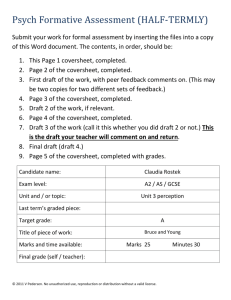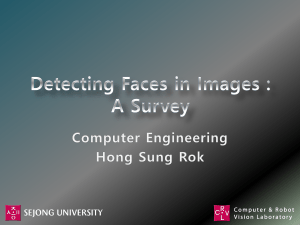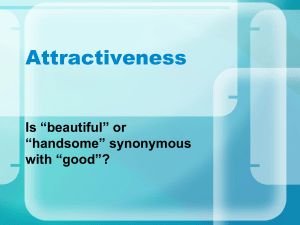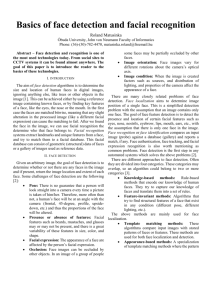Describe and evaluate Bruce and Young`s theory
advertisement
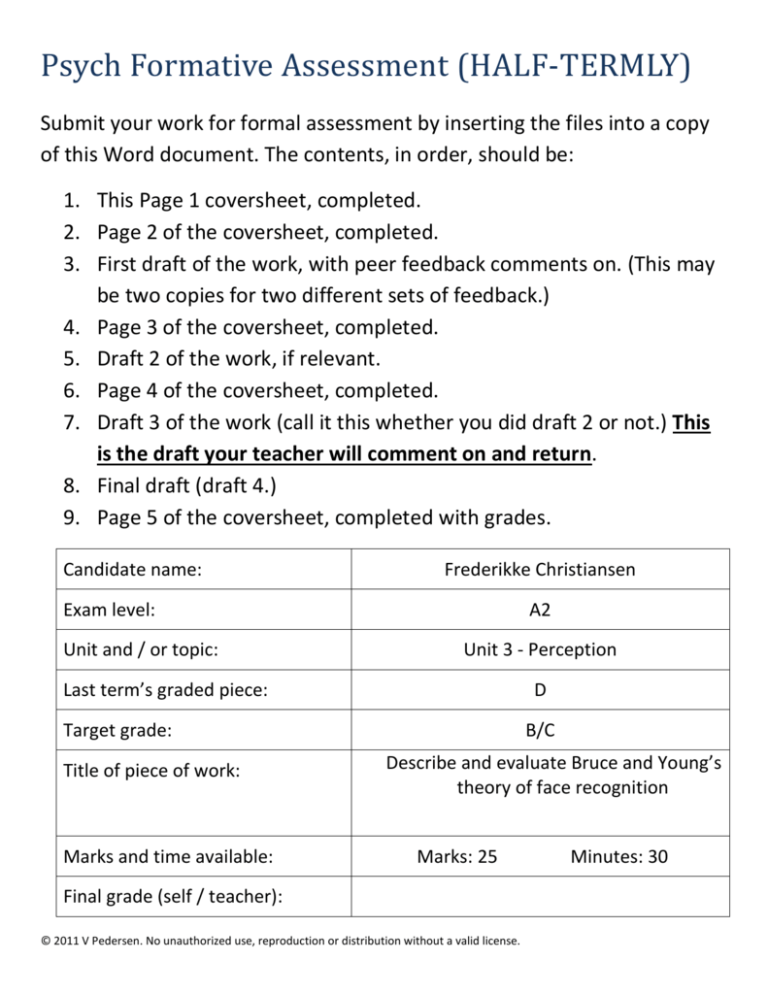
Psych Formative Assessment (HALF-TERMLY) Submit your work for formal assessment by inserting the files into a copy of this Word document. The contents, in order, should be: 1. This Page 1 coversheet, completed. 2. Page 2 of the coversheet, completed. 3. First draft of the work, with peer feedback comments on. (This may be two copies for two different sets of feedback.) 4. Page 3 of the coversheet, completed. 5. Draft 2 of the work, if relevant. 6. Page 4 of the coversheet, completed. 7. Draft 3 of the work (call it this whether you did draft 2 or not.) This is the draft your teacher will comment on and return. 8. Final draft (draft 4.) 9. Page 5 of the coversheet, completed with grades. Candidate name: Frederikke Christiansen Exam level: Unit and / or topic: A2 Unit 3 - Perception Last term’s graded piece: D Target grade: Title of piece of work: Marks and time available: B/C Describe and evaluate Bruce and Young’s theory of face recognition Marks: 25 Final grade (self / teacher): © 2011 V Pedersen. No unauthorized use, reproduction or distribution without a valid license. Minutes: 30 Psych Formative – Page 2 Place this sheet BEFORE the PEER-COMMENTEDFIRST DRAFT. Peer markers should give comment and advice on the work using the “Review” function in Word. They should not give a grade. They should give an even balance of praise and criticism. The two peer markers for my work were: (names + surnames) Rachel Thornton Connor Jewell Include BOTH peer markers’ commented essays or the teacher won’t help. © 2011 V Pedersen. No unauthorized use, reproduction or distribution without a valid license. Describe and evaluate Bruce and Young’s theory of face recognition Bruce and Young first introduced this model of in 1986 and since then the theory has been the most influential model of face recognition. Bruce and Young argued that face recognition is mainly a holistic process and claims that it involves several independent subprocesses working in unison. Bruce and Young have identified 8 of these components starting with structural encoding which constructs various representations and descriptions of faces. The next component of the theory was expression analysis, allowing people to draw conclusions about an individual’s facial expression. Facial speech analysis looks at facial movements to help understand speech, directed visual processing specific facial information is processed selectively, face recognition units stores structural descriptions of familiar faces. Personal identity nodes store information about known individuals, for example their job or their interests. The name generation component claims that names are stored separately from other information; lastly the cognitive system holds additional information which might be able to help the recognition process. Another feature of Bruce and Young’s theory is what is known as the ‘view-centered description, this is used to detect simple physical aspects of the face, for example age, gender, ect. It is claimed that most analysis made at this stage is on a feature-by-feature basic, which is used to create a structural model of the face which is then used to compare the other faces in memory. This explains why the same person seen from a variety of different angles is still able to be recognized. Perett and Oram (1993) conducted a study with monkey’s which proved that different templates of the same faces are stored in the brain. This model also suggests that familiar and unfamiliar faces are processed in slightly different ways. There are evidence of case studies of people with prosopagnosia, which highlights the different aspects of Bruce and Young’s theory, for example VA, reported by DeRenzi et al (1991), could identify his own handwriting and distinguish between coins from different currencies but was profoundly prosopagnosic, this simply shows that inanimate objects are processed independently, separately from face recognition, as they don’t need to use the expression analysis or facial speech analysis components to recognise the objects. Another case study which proves this is RM, who was able to distinguish between his large collection of model cars better than control ppts. Mr. W, was a farmer who got diagnosed with prosopagnosia and lost his ability to recognise familiar faces, however, was still able to distinguish between the cows in his heard. This shows that face recognition is distinct from other types of object processing. McGurk and McDonald (1976) shows ppts a video of someone enunciating single-syllable sounds while the audio track played a different sound. © 2011 V Pedersen. No unauthorized use, reproduction or distribution without a valid license. They found that ppts would report hearing a fusion of the two sounds. This suggests that the mechanisms for facial speech analysis and face recognition are also independent. Psychologists state that this model has been very influential and can explain and predict many research findings; however critics of the holistic theory argue that features are too important to ignore. Feature analysis theorists argue that face recognition is a bottom-up process, meaning you recognise the features before looking at holistic features (e.g. spacing and facial shape). Davies and Ellis (1981) carried out a study where they briefly showed ppts images of unfamiliar faces and asked them to recall what the face looked like; it was found that the ppts recalled facial features such as eyes, hair, nose and mouth before describing the unfamiliar faces’ facial shape. Although, Yin (1969) carried out a contradicting study where ppts were shown inversed objects as well as inversed faces, they found that the ppts were able to recognise the objects, however found it difficult to recognise the faces. Yin claims that inversing images of a face impairs holistic processing but not feature analysis processing, therefore he claims that faces must be processed holistically. Aspects of Bruce and Young’s theory, for example the cognitive system, critics argue that the role of this system is unclear and undeveloped. Critics have also argued against the evidence of the case studies mentioned, as each brain damage is unique and cannot be generalised to the entire population. This model also mainly focuses on the recognition of familiar faces and is unable to explain how, for example, eyewitness identification of unfamiliar faces can be improved; it also doesn’t take into account the process involved in learning to recognise new faces and storing these in the fusiform gyrus. © 2011 V Pedersen. No unauthorized use, reproduction or distribution without a valid license. Describe and evaluate Bruce and Young’s theory of face recognition Bruce and Young first introduced this model of in 1986 and since then the theory has been the most influential model of face recognition. Bruce and Young argued that face recognition is mainly a holistic process and claims that it involves several independent subprocesses working in unison. Bruce and Young have identified 8 of these components starting with structural encoding which constructs various representations and descriptions of faces. The next component of the theory was expression analysis, allowing people to draw conclusions about an individual’s facial expression. Facial speech analysis looks at facial movements to help understand speech, directed visual processing specific facial information is processed selectively, face recognition units stores structural descriptions of familiar faces. Personal identity nodes store information about known individuals, for example their job or their interests. The name generation component claims that names are stored separately from other information; lastly the cognitive system holds additional information which might be able to help the recognition process. Another feature of Bruce and Young’s theory is what is known as the ‘view-centered description, this is used to detect simple physical aspects of the face, for example age, gender, ect. It is claimed that most analysis made at this stage is on a feature-by-feature basic, which is used to create a structural model of the face which is then used to compare the other faces in memory. This explains why the same person seen from a variety of different angles is still able to be recognized. Perett and Oram (1993) conducted a study with monkey’s which proved that different templates of the same faces are stored in the brain. This model also suggests that familiar and unfamiliar faces are processed in slightly different ways. There are evidence of case studies of people with prosopagnosia, which highlights the different aspects of Bruce and Young’s theory, for example VA, reported by DeRenzi et al (1991), could identify his own handwriting and distinguish between coins from different currencies but was profoundly prosopagnosic, this simply shows that inanimate objects are processed independently, separately from face recognition, as they don’t need to use the expression analysis or facial speech analysis components to recognise the objects. Another case study which proves this is RM, who was able to distinguish between his large collection of model cars better than control ppts. Mr. W, was a farmer who got diagnosed with prosopagnosia and lost his ability to recognise familiar faces, however, was still able to distinguish between the cows in his heard. This shows that face recognition is distinct from other types of object processing. McGurk and McDonald (1976) shows ppts a video of someone enunciating single-syllable sounds while the audio track played a different sound. © 2011 V Pedersen. No unauthorized use, reproduction or distribution without a valid license. They found that ppts would report hearing a fusion of the two sounds. This suggests that the mechanisms for facial speech analysis and face recognition are also independent. Psychologists state that this model has been very influential and can explain and predict many research findings; however critics of the holistic theory argue that features are too important to ignore. Feature analysis theorists argue that face recognition is a bottom-up process, meaning you recognise the features before looking at holistic features (e.g. spacing and facial shape). Davies and Ellis (1981) carried out a study where they briefly showed ppts images of unfamiliar faces and asked them to recall what the face looked like; it was found that the ppts recalled facial features such as eyes, hair, nose and mouth before describing the unfamiliar faces’ facial shape. Although, Yin (1969) carried out a contradicting study where ppts were shown inversed objects as well as inversed faces, they found that the ppts were able to recognise the objects, however found it difficult to recognise the faces. Yin claims that inversing images of a face impairs holistic processing but not feature analysis processing, therefore he claims that faces must be processed holistically. Aspects of Bruce and Young’s theory, for example the cognitive system, critics argue that the role of this system is unclear and undeveloped. Critics have also argued against the evidence of the case studies mentioned, as each brain damage is unique and cannot be generalised to the entire population. This model also mainly focuses on the recognition of familiar faces and is unable to explain how, for example, eyewitness identification of unfamiliar faces can be improved; it also doesn’t take into account the process involved in learning to recognise new faces and storing these in the fusiform gyrus. © 2011 V Pedersen. No unauthorized use, reproduction or distribution without a valid license. Psych Formative – Page 3 From the advice of your peer markers, write 5-10 lines summarizing what you think you most need to work on and change (this box expands as you write): If peer feedback revealed major issues you need to fix BEFORE asking for the teacher’s help, then redraft (draft 2). Otherwise, you can now pass this on to the teacher. © 2011 V Pedersen. No unauthorized use, reproduction or distribution without a valid license. Psych Formative – Page4 Place this sheet AFTER the new draft you did following peer feedback. (If no redraft, this is straight after the Stage 2 sheet.) Remember that the amount of teacher feedback you can get is very limited and you should use it carefully and sparingly. Place a cross (“X”) in ONE box: “I HAVE redrafted after peer feedback” “I HAVE NOT redrafted after peer feedback” X Now send all of the above on to your teacher. Make sure EVERYTHING is included IN ORDER before you send it. Your teacher will add their comments. After it’s returned you will need to do a FINAL DRAFT bearing the teacher’s advice in mind. © 2011 V Pedersen. No unauthorized use, reproduction or distribution without a valid license. Psych Formative – Page5 Draft 3, with guidance comments from the teacher, should be BEFORE this sheet. Now rewrite it. You may want to use this box to plan the changes you need to make (about 2-3 lines will do): AFTER this sheet, place thatFinal Draft with improvements made following the teacher’s advice. When you have done that, return to the front sheet: use the mark scheme to give yourself a final grade your teacher will add their view if these are different, find some lesson time to ask about it FINALLY – print it, staple it, and keep it in the folder in the classroom (this will enable you to refer back to it with your teacher in order to keep track of your progress.) © 2011 V Pedersen. No unauthorized use, reproduction or distribution without a valid license. From plan to feedback to grade (appendix) Planning might require just a half-page, or a list of key terms that must be used. Summative marking Formative feedback Planning / drafting START HERE Key terms list Plan it First draft Peer feedback Depending on your confidence level, you might do the essay under timed conditions (or not), open book or closed, with plan and key terms list visible (or not.) Try to move up these confidence levels – but not too fast. Rewrite Teacher feedback Final rewrite Self- or peer-grade Teacher confirms © 2011 V Pedersen. No unauthorized use, reproduction or distribution without a valid license. Peer feedback must come first and is more important than teacher feedback. In the short route, this is followed by teacher feedback; or you can redraft from peer feedback before getting teacher help. You won’t get teacher help without evidence of meaningful peer feedback first. Don’t hand the work to the teacher to mark summatively. You must be able to use the mark scheme to grade it yourself – or you don’t understand what the examiner wants. The teacher can help you “home in” on marking accuracy but the onus is on you to learn this skill.


